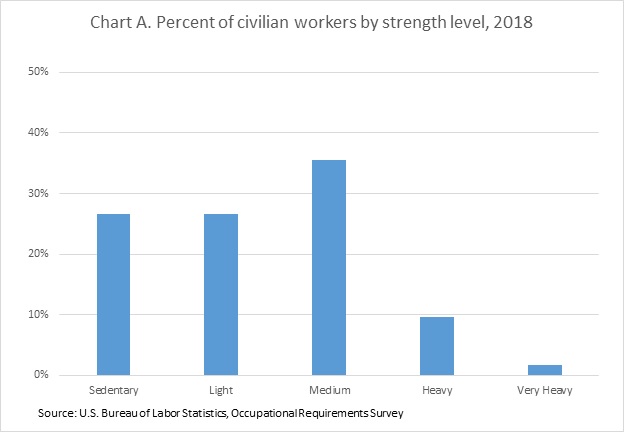An official website of the United States government
 United States Department of Labor
United States Department of Labor
The Occupational Requirements Survey (ORS) provides information about the physical demands for civilian workers in the U.S. economy. The job requirements reflect those necessary for workers to perform critical tasks in support of the critical job functions, and not the capabilities of individual workers. The ORS’ strength estimates are part of the physical demands provided by the ORS program.
The ORS publishes five strength levels (sedentary, light, medium, heavy, and very heavy), which are based on the job requirements for performing physical demands within specific weight classes and the duration of these demands.
In 2018, a medium strength level was required for 35.5 percent of workers in the U.S. economy. Sedentary and light strength levels were each required for 26.6 percent of workers. A heavy strength level was required for 9.6 percent of workers and 1.7 percent had a very heavy strength level. (See Chart A.)

Strength levels are calculated from the weight and duration associated with lifting, carrying, and in some cases, standing or walking. A duration chart is used to calculate the amount of time spent lifting or carrying. There are four categories of time in relation to an individual’s workday schedule: seldom (up to 2 percent), occasional (2 percent to one-third), frequent (one-third to two-thirds), and constant (two-thirds or more). “None” and “negligible weight” are additional categories.
For example, if workers deliver items weighing between 21-50 pounds occasionally, then the job would be classified as a medium strength level. However, if they delivered slightly heavier items (26-50 pounds) frequently, then the job would be classified as a heavy strength level.
| Strength level | Duration of lifting or carrying | |||
|---|---|---|---|---|
| Seldom | Occasionally | Frequently | Constantly | |
|
Light work |
11-20 pounds | 11-20 pounds | 1-10 pounds | Negligible weight |
|
Medium work |
21-50 pounds | 21-50 pounds | 11-25 pounds | 1-10 pounds |
|
Heavy work |
51-100 pounds | 51-100 pounds | 26-50 pounds | 11-20 pounds |
|
Very heavy work |
>100 pounds | >100 pounds | >50 pounds | >20 pounds |
| Strength level | Description | ||
|---|---|---|---|
|
Unknown |
If it is unknown whether lifting or carrying occurs occasionally, frequently, or constantly or none of the conditions in the strength level chart are met and standing or walking or sitting are unknown. | ||
|
Sedentary |
If none of the conditions in the strength level chart are met and standing or walking occurs less than or equal to 1/3 of the work schedule. | ||
|
Light work |
If none of the conditions in the strength chart are met and does not meet the special conditions for unknown or sedentary. | ||
Strength is considered sedentary when none of the conditions in the strength chart are met and standing or walking is less than or equal to one-third of the work schedule or work day (see Tables 1 and 2).
Table 3 provides the percent of workers with a sedentary strength level by occupation. Some examples include bill and account collectors (97.4 percent), financial analysts (96.8 percent), data entry keyers (96.6 percent), tellers (19.8 percent), and teacher assistants (9.3 percent) with a sedentary strength level.
| Occupation | Percent |
|---|---|
|
Bill and account collectors |
97.4% |
|
Financial analysts |
96.8% |
|
Data entry keyers |
96.6% |
|
Software developers, applications |
95.3% |
|
Computer systems analysts |
93.5% |
|
Payroll and timekeeping clerks |
92.2% |
|
Accountants |
91.6% |
|
Insurance underwriters |
91.5% |
|
Tax preparers |
90.1% |
|
Auditors |
89.1% |
|
Software quality assurance engineers and testers |
88.9% |
|
Insurance sales agents |
88.7% |
|
Management analysts |
88.5% |
|
Human resources specialists |
88.5% |
|
Wholesale and retail buyers, except farm products |
48.6% |
|
General and operations managers |
46.3% |
|
Child, family, and school social workers |
45.3% |
|
Mental health and substance abuse social workers |
43.7% |
|
Property, real estate, and community association managers |
43.4% |
|
Dental hygienists |
42.8% |
|
Construction managers |
39.9% |
|
Medical and health services managers |
38.1% |
|
Sales representatives, wholesale and manufacturing, technical and scientific products |
36.0% |
|
Social and human service assistants |
35.1% |
|
Education administrators, elementary and secondary school |
24.0% |
|
Tellers |
19.8% |
|
Teacher Assistants |
9.3% |
|
Source: U.S. Bureau of Labor Statistics, Occupational Requirements Survey |
|
For more information about ORS collection processes see the collection materials. The ORS Handbook of Methods provides details on sampling methodology, calculations, weighting, and history of the ORS program. More information is available at www.bls.gov/ors.